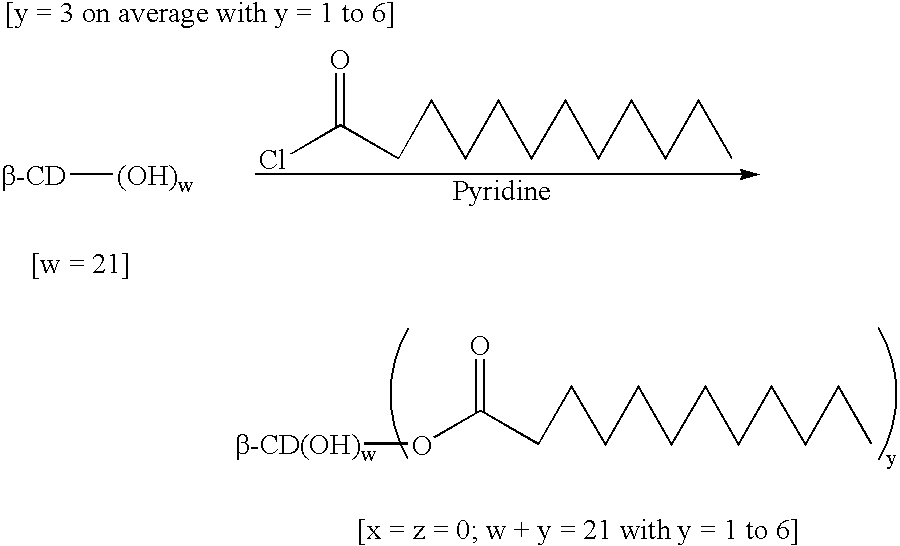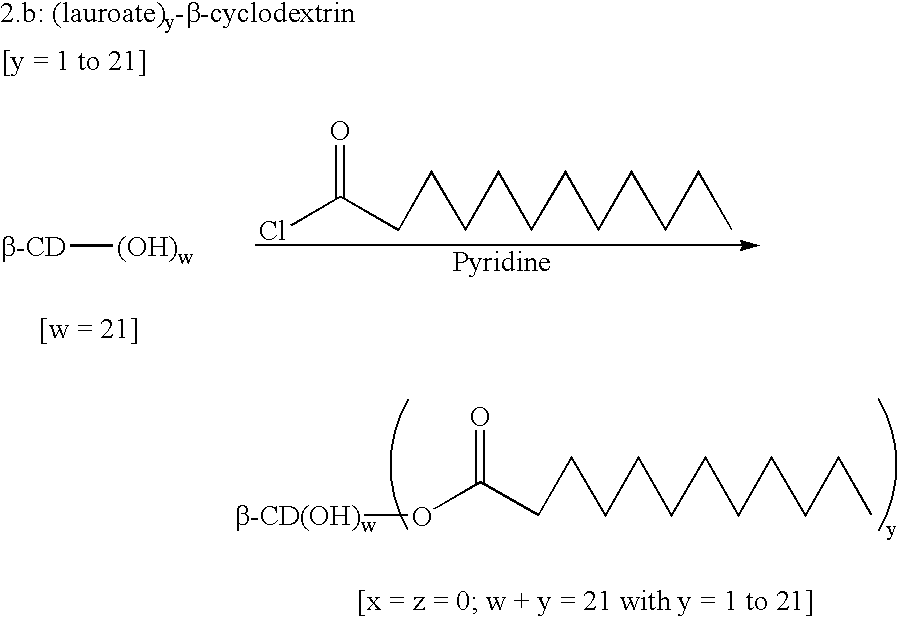Cyclodextrins preferentially substituted on their primary face by acid or amine functions
a technology of cyclodextrins and primary faces, applied in the field of alpha, beta or gamma cyclodextrins, can solve the problems of poor solubility in aqueous phase, high geometry of cyclodextrins substituted on their primary face, and unfavorable formation of nanoparticles, so as to improve the bioavailability of pharmaceutically active substances
- Summary
- Abstract
- Description
- Claims
- Application Information
AI Technical Summary
Benefits of technology
Problems solved by technology
Method used
Image
Examples
example 1
(Lauroate).sub.y -.beta.-cyclodextrin
##STR1##
The anhydrous .beta.-cyclodextrin (42.23 g, 1 eq.) was dissolved in freshly distilled pyridine (750 ml, 23.degree. C.) under nitrogen. Lauric acid chloride (34.5 ml, 4 eq.) was added dropwise at ambient temperature and the reaction was left, with stirring, for 24 hours. The solution was poured into water (500 ml, pH=2), The pH was kept at 2 with HCl and the precipitate obtained was filtered and washed with water (500 ml, pH=2). The white powder (65 g) was vacuum dried (10.2 Torr) for 5 hours at 60.degree. C.
The product obtained was a mixture of .beta.-cyclodextrin substituted with 1 to 6 fatty acid chains, principally 2 and 3 lauric acid chains. For this reason, in this example, y is an average of 3 but can vary from 1 to 6.
example 2
(Lauroate).sub.y -.beta.-cyclodextrin
##STR2##
The anhydrous .beta.-cyclodextrin (50.12 g, 1 eq.) was dissolved in freshly distilled pyridine (750 ml, 23.degree. C.) under nitrogen. Lauric acid chloride (93.78 ml, 9 eq.) was added dropwise at ambient temperature and the reaction was left, with stirring, for 24 hours. The solution was poured into water (500 ml, pH=2). The pH was kept at 2 with HCl. The precipitate obtained (0.13 g) was filtered and vacuum dried (10.sup.-2 Torr) for 5 hours at 60.degree. C.
The product obtained was a mixture of 13-cyclodextrin substituted with 6 to 10 fatty acid chains, principally 7, 8 and 9 lauric acid chains.
Silica column chromatography was used to separate the different compounds.
Substitution of the primary alcohols was demonstrated by .sup.1 H NMR of a compound containing 7 lauric acid chains. The primary alcohol peak OH-6 (.delta.=4.47 ppm, DMSO-d.sup.6) disappeared, the alcohol being substituted by an ester. The secondary alcohols (.delta.=5.73 pp...
example 3
(Alkyloate).sub.y -.beta.-cyclodextrin
[y=1 to 21] ##STR4##
The anhydrous .beta.-cyclodextrin (1.71 g, 1 eq.) was dissolved in freshly distilled pyridine (750 ml, 23.degree. C.) under nitrogen. Hexanoic acid chloride (1.97 ml, 9 eq.) was added dropwise at ambient temperature and the reaction was left, with stirring, for 24 hours. The solution was poured into water (100 ml, pH=2). The pH was kept at 2 with HCl and the precipitate obtained was filtered then washed with water (500 ml, pH=2). The white powder (2.1 g) was vacuum dried (10.sup.-2 Torr) for 5 hours at 60.degree. C.
The product obtained was a mixture of .beta.-cyclodextrin substituted with 6 to 10 fatty acid chains, principally 7, 8 and 9 hexanoic acid chains.
3.b: Chain Length Modification
The preparation was carried out as described in example 3.a but in the presence of a butyric acid chloride (C4), a caprylic acid chloride (C8), a capric acid chloride (C10), a myristic acid chloride (C14), a palmitic acid chloride (C16), a st...
PUM
| Property | Measurement | Unit |
|---|---|---|
| Fraction | aaaaa | aaaaa |
| Temperature | aaaaa | aaaaa |
| Temperature | aaaaa | aaaaa |
Abstract
Description
Claims
Application Information
 Login to View More
Login to View More - R&D
- Intellectual Property
- Life Sciences
- Materials
- Tech Scout
- Unparalleled Data Quality
- Higher Quality Content
- 60% Fewer Hallucinations
Browse by: Latest US Patents, China's latest patents, Technical Efficacy Thesaurus, Application Domain, Technology Topic, Popular Technical Reports.
© 2025 PatSnap. All rights reserved.Legal|Privacy policy|Modern Slavery Act Transparency Statement|Sitemap|About US| Contact US: help@patsnap.com



